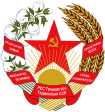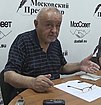Communist Party of Tajikistan
You can help expand this article with text translated from the corresponding article in Russian. (February 2013) Click [show] for important translation instructions.
|
 | |
| Abbreviation | CPT (English) HKT (Tajik) KPT (Russian) |
| Leader | Miroj Abdulloyev |
| Founded | 6 December 1924 |
| Headquarters | Fatekh Niyazi 37, Dushanbe. 734002 |
| Membership (2020) | 52,000 |
| Ideology | Communism Marxism–Leninism Soviet patriotism |
| Political position | Far-left |
| National affiliation | Communist Party of the Soviet Union (until 1991) |
| Regional affiliation | UCP–CPSU |
| International affiliation | Comintern (1924–1943) Cominform (1947–1956) IMCWP |
| Colours | Red |
| Slogan | Workers of the world, unite |
| Anthem | The Internationale |
| Assembly of Representatives | 2 / 61 |
| Website | |
| kpt.freenet.tj | |
The Communist Party of Tajikistan[a] is the oldest political party in Tajikistan. The party was founded on 6 December 1924 and was the ruling party of the Tajik Autonomous Soviet Socialist Republic from 1924 to 1929 and the Tajik Soviet Socialist Republic from 1929 to 1990 as part of the Soviet Union as a republican branch of the Communist Party of the Soviet Union. It was banned in 1991 following the 1991 coup.
The CPT is a based on the concept of democratic centralism, a principle conceived by Russian Marxist Vladimir Lenin, that entails democratic and open discussion of policy issues within the party followed by the requirement of total unity in upholding the agreed policies. The highest institution of the party was the Party Congress, which elects the Central Committee. In between party congresses, the Central Committee is the highest decision-making organ regarding party affairs. After a party congress, the Central Committee elects the Politburo and Secretariat, as well as the First Secretary, the highest party officer.
The party is committed to communism and participates in the International Meeting of Communist and Workers' Parties, an annual international forum of communist parties. According to the party statute, the party adheres to Marxism–Leninism, based on the writings of Vladimir Lenin and Karl Marx, and formalized under Joseph Stalin. The party had pursued state socialism,[1] under which all industries were nationalized and a command economy was introduced. Prior to the adoption of central planning in 1929, Lenin had introduced a mixed economy, commonly referred to as the New Economic Policy, in the 1920s, which allowed to introduce certain capitalist elements in the Soviet economy. This changed upon the ascension of Mikhail Gorbachev in 1985 when he and his allies envisioned the introduction of an economy similar to Lenin's earlier New Economic Policy through a program of "perestroika", or restructuring, but their reforms, leading to the unraveling of the CPT in the 1990 Dushanbe riots, the banning of the CPT in 1991 and the dissolution of the Soviet Union. The party managed to remain in power until 2000 when it was overtaken by the People's Democratic Party of Tajikistan but the party improved when it won 13.97% of the popular vote and 4 out of 63 seats in the 2005 election.[2]
Today, the party is affiliated to the Union of Communist Parties – Communist Party of the Soviet Union.
History
[edit]Soviet era
[edit]The first social democratic groups arose in Tajikistan during the 1905 Russian Revolution and by late 1917 and early 1918, Bolshevik organizations were created in Khodjent, Ura-Tyube, Penjikent, and Shurab. On 6 December 1924, the government formed the Organizing Bureau of the Central Committee of the Communist Party of Uzbekistan in the Tajik Autonomous Soviet Socialist Republic. The first Tajik party conference was held between 21 and 27 October 1927. On 25 November 1929, by the decision of the Politburo of the CPSU, the CPT was formed by separation from the CPU. In 1975, the CPT had more than 94,000 members.
Regional and city committees
[edit]- Dushanbe City Committee
- Garm Regional Committee
- Gorno-Badakhshan Regional Committee *Kulyab Regional Committee
- Kurgan-Tyubinsk Regional Committee *Stalinabad Regional Committee
- Ura-Tyuba Regional Committee
Post-independence
[edit]After becoming independent, it was voted to rename the CPT the Socialist Party of Tajikistan; however, by December 1991, the ban on the activities of the Communist Party was lifted.[3][4] During the Tajikistani Civil War, the CPT supported the government and the Popular Front of Tajikistan. At present, the Communist Party of Tajikistan supports the government of Emomali Rahmon. Beginning in the 2000s, the CPT lost the majority of its electorate, with today's electorate of the party being made up mainly of people of retirement age.
Leaders
[edit]First Secretary of the Communist Party of Tajikistan (1924–1991)
[edit]| No. | Picture | Name
(Birth–Death) |
Took office | Left office | Political party |
|---|---|---|---|---|---|
| First Secretary | |||||
| 1 | 
|
Chinor Emomov (1898–1939) |
1924 | 1927 | CPSU |
| 2 | 
|
Mumin Khojaev (?–?) |
1927 | 1928 | CPSU |
| 3 | 
|
Ali Shervoni (?–?) |
1928 | 1929 | CPSU |
| 4 | 
|
Shirinsho Shotemur (1899–1937) |
1929 | 1930 | CPSU |
| 5 | 
|
Mirza Huseynov (1894–1938) |
1930 | 1933 | CPSU |
| 6 | 
|
Grigory Broydo (1883–1956) |
1933 | 1934 | CPSU |
| 7 | 
|
Suren Shadunts (1898–1938) |
1934 | 1936 | CPSU |
| 8 | 
|
Urunboi Ashurov (1903–1938) |
1936 | 1937 | CPSU |
| 9 | 
|
Dmitri Protopopov (1897–1986) |
1937 | 1946 | CPSU |
| 10 | 
|
Bobojon Ghafurov (1908–1977) |
1946 | 1956 | CPSU |
| 11 | 
|
Tursun Uljabayev (1916–1988) |
1956 | 1961 | CPSU |
| 12 | 
|
Jabbor Rasulov (1913–1982) |
1961 | 1982 | CPSU |
| 13 | 
|
Rahmon Nabiyev (1930–1993) |
1982 | 1985 | CPSU |
| 14 | 
|
Qahhor Mahkamov (1932–2016) |
1985 | 1991 | CPSU |
Second Secretaries
[edit]- Shirinsho Shotemur (1930–1932)[5]
- Ibrahim Ismailov (1932–1934)
- Saifullo Abdulloev (1936–1937)
- Petru Lucinschi (1986–1989)[6]
Chairman of the Communist Party of Tajikistan (1991–Present)
[edit]| No. | Picture | Name
(Birth–Death) |
Took office | Left office |
|---|---|---|---|---|
| Chairman | ||||
| 1 | 
|
Shodi Shabdolov
(1943–2023) |
4 September 1991 | 2 July 2016 |
| 2 | 
|
Ismoil Talbakov (1955–2016) |
2 July 2016 | 17 December 2016 |
| 3 | 
|
Mirzoazim Nasimov (?–?) |
17 December 2016 | 22 April 2017 |
| 4 | 
|
Miroj Abdulloyev (born 1948) |
22 April 2017 | Incumbent |
Electoral history
[edit]Presidential elections
[edit]| Election | Party candidate | Votes | % | Result |
|---|---|---|---|---|
| 1991 | Rahmon Nabiyev | 60.4% | Elected | |
| 2006 | Ismoil Talbakov | 159,493 | 5.2% | Lost |
| 2013 | Ismoil Talbakov | 181,675 | 5.04% | Lost |
| 2020 | Miroj Abdulloyev | 49,535 | 1.18% | Lost |
Assembly of Representatives elections
[edit]| Election | Votes | % | Seats | +/– | Position | Government |
|---|---|---|---|---|---|---|
| 1995 | 33.1% | 60 / 181
|
Majority | |||
| 2000 | 547,076 | 20.39% | 13 / 63
|
Opposition | ||
| 2005 | 533,066 | 20.63% | 4 / 63
|
Opposition | ||
| 2010 | 229,080 | 7.01% | 2 / 63
|
Opposition | ||
| 2015 | 86,060 | 2.32% | 2 / 63
|
Opposition | ||
| 2020 | 132,049 | 3.11% | 2 / 63
|
Opposition |
See also
[edit]Notes
[edit]References
[edit]- ^ Pyrih, R. Communist Party of Ukraine, the Soviet period (КОМУНІСТИЧНА ПАРТІЯ УКРАЇНИ РАДЯНСЬКОЇ ДОБИ). Encyclopedia of History of Ukraine. 2007
- ^ PARLINE database on national parliaments – Tajikistan Majlisi namoyandogon (House of Representatives) – Last Election
- ^ Договор ратифицирован, а компартия признана невиновной // «Известия», 26 декабря 1991, № 306
- ^ Энциклопедия Кольера
- ^ Tunçer-Kılavuz, Idil (2014-06-27). Power, Networks and Violent Conflict in Central Asia: A Comparison of Tajikistan and Uzbekistan. Routledge. ISBN 9781317805113.
- ^ "He was in office of Second Secretary of the Central Committee of the Communist Party of Tajikistan during 1986–1989".
- Communist Party of Tajikistan
- 1924 establishments in Tajikistan
- Branches of the Communist Party of the Soviet Union
- Communism in Tajikistan
- Communist parties in the former Soviet Union
- Communist parties in Asia
- Political parties in Tajikistan
- Formerly ruling communist parties
- International Meeting of Communist and Workers Parties
- Tajikistani Civil War
- Communist party stubs
- Asian political party stubs
- Tajikistan stubs
